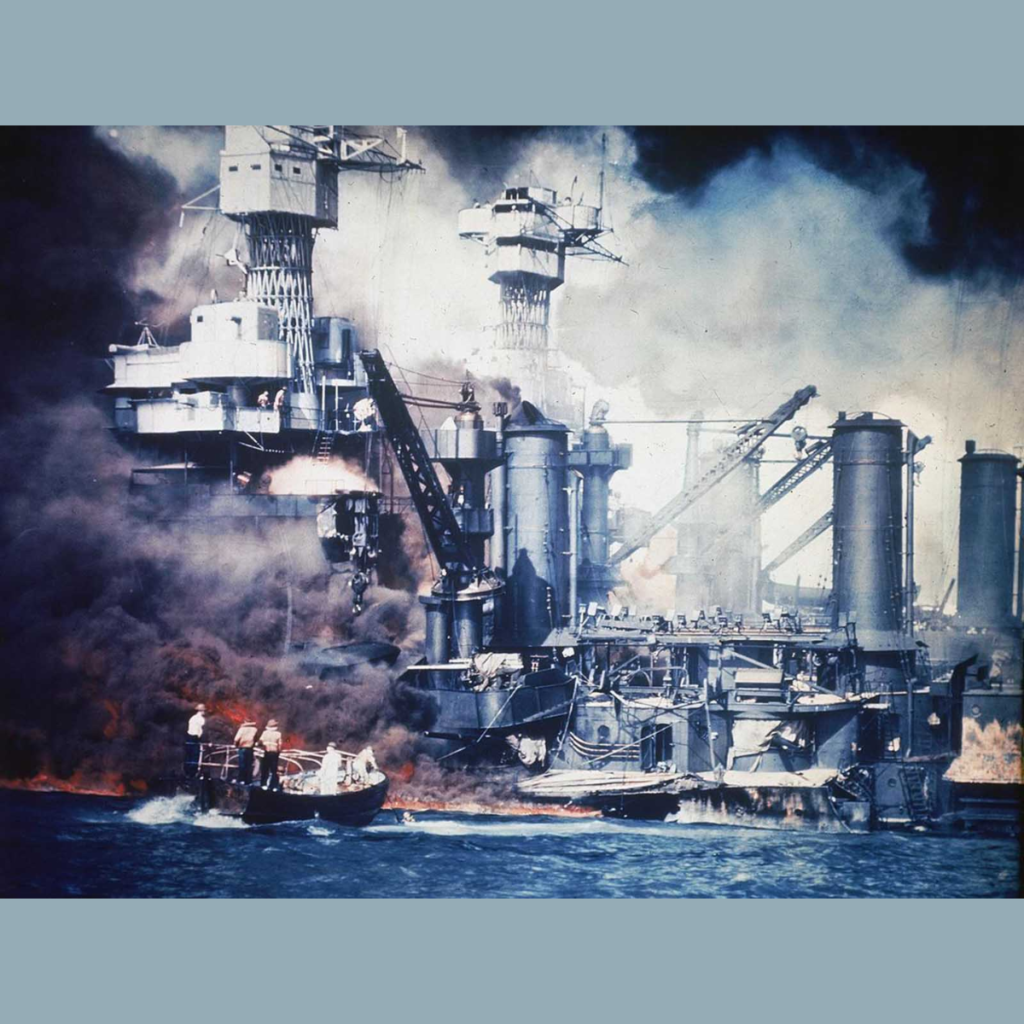

The USS Shaw explodes after being hit by bombs during the Japanese surprise attack on Pearl Harbor, Hawaii, in this December 7, 1941 photo.
The Japanese surprise attack on Pearl Harbor began just before 8 a.m. local time Sunday morning, December 7, 1941. For over an hour, in two waves, some 350 Japanese aircraft—having taken off from six aircraft carriers 230 miles north of Oahu—attacked the naval base.
Japanese forces wreaked havoc on US naval vessels and on US aircraft on the island’s airfield. In all, 2,403 Americans, including 68 civilians, died in the attack. In comparison, Japan suffered relatively light causalities—it lost only 29 aircraft and a few mini-submarines.
The American people were shocked, bewildered, surprised, and angered by the attack. On December 8, President Roosevelt addressed a joint session of Congress in the Capitol, his words broadcast on radio to the nation: “Yesterday, December 7, 1941—a date which will live in infamy—the United States of America was suddenly and deliberately attacked by naval and air forces of the Empire of Japan”.

Japanese pilots get instructions aboard an aircraft carrier before the attack on Pearl Harbor, in this scene from a Japanese newsreel. It was obtained by the U.S. War Department and released to U.S. newsreels.
In his address, Roosevelt asked Congress to declare war against Japan, which it did that day. Three days later, Japan’s allies Germany and Italy declared war on the United States, and Congress reciprocated the same day.
All previous domestic opposition to US entry into the war ceased. The United States was now immersed in a war it would conduct simultaneously in Europe and the Pacific.
The Japanese government decided to attack Pearl Harbor after the United States cut off US oil exports to Japan in the summer of 1941. Japan relied on the United States for eighty percent of its oil, and without US oil supplies its navy would be unable to function.
In attacking Pearl Harbor the Japanese hoped to cripple or destroy the US Pacific fleet so that the Japanese navy would have free reign in the Pacific.

The Japanese aircraft carrier Zuikaku, seen in September of 1941. The Zuikaku would soon sail toward Hawaii, one of six aircraft carriers used in the attack by the Imperial Japanese Navy.
Japan was also motivated strategically by ideas of creating an Asian co-prosperity sphere—“Asia for Asians”—in which Japan would take over the Asian colonial holdings of Europe and the United States. With the British, French, and Dutch caught up in the war in Europe, the Japanese believed the European powers would be unable to defend their Asian colonial holdings.
Indeed, in the eight hours following the Pearl Harbor attack, Japan also attacked British-held Singapore, Hong Kong, and Malaya, and the US territorial possessions of the Philippines, Guam, and Wake Island.
While the attack accomplished its intended objective, it turned out to be largely unnecessary. Unbeknownst to Yamamoto, who conceived the original plan, the U.S. Navy had decided as far back as 1935 to abandon ‘charging’ across the Pacific towards the Philippines in response to an outbreak of war.
The U.S. instead adopted “Plan Dog” in 1940, which emphasized keeping the IJN out of the eastern Pacific and away from the shipping lanes to Australia, while the U.S. concentrated on defeating Nazi Germany.

Aircraft prepare to launch from the Imperial Japanese Navy aircraft carrier Akagi during the December 7, 1941 attack on Pearl Harbor, Hawaii.
Fortunately for the United States, the American aircraft carriers were untouched by the Japanese attack; otherwise the Pacific Fleet’s ability to conduct offensive operations would have been crippled for a year or more (given no diversions from the Atlantic Fleet).
As it was, the elimination of the battleships left the U.S. Navy with no choice but to rely on its aircraft carriers and submarines—the very weapons with which the U.S. Navy halted and eventually reversed the Japanese advance.
While six of the eight battleships were repaired and returned to service, their relatively low speed and high fuel consumption limited their deployment, and they served mainly in shore bombardment roles (their only major action being the Battle of Surigao Strait in October 1944).
A major flaw of Japanese strategic thinking was a belief that the ultimate Pacific battle would be fought by battleships, in keeping with the doctrine of Captain Alfred Thayer Mahan. As a result, Yamamoto (and his successors) hoarded battleships for a “decisive battle” that never happened.

This photograph, from a Japanese film later captured by American forces, was taken aboard the Japanese aircraft carrier Zuikaku, just as a Nakajima “Kate” B-5N bomber launched off the deck to attack Pearl Harbor, Hawaii, on December 7, 1941.

Aerial view of the initial blows struck against American ships, as seen from a Japanese plane over Pearl Harbor.
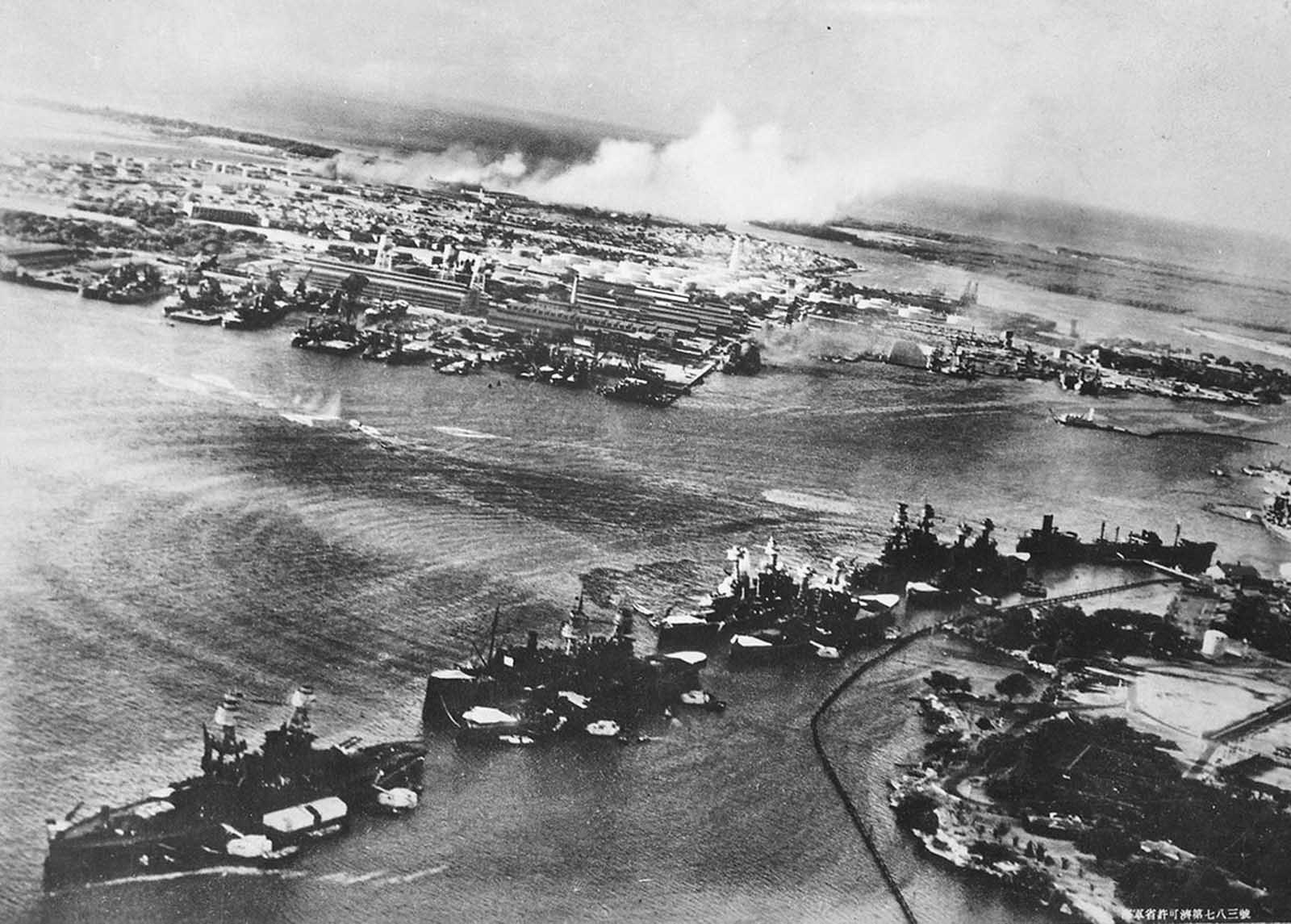
Captured Japanese photograph taken during the attack on Pearl Harbor, December 7, 1941. In the distance, the smoke rises from Hickam Field.

Seen from a distance, the Battleship Arizona burns as it sinks in Pearl Harbor after the December 7, 1941 raid by Japanese bombers.

A Japanese bomber, its diving flaps down, was photographed by a U.S. Navy photographer as the plane approached its Pearl Harbor objective on December 7.
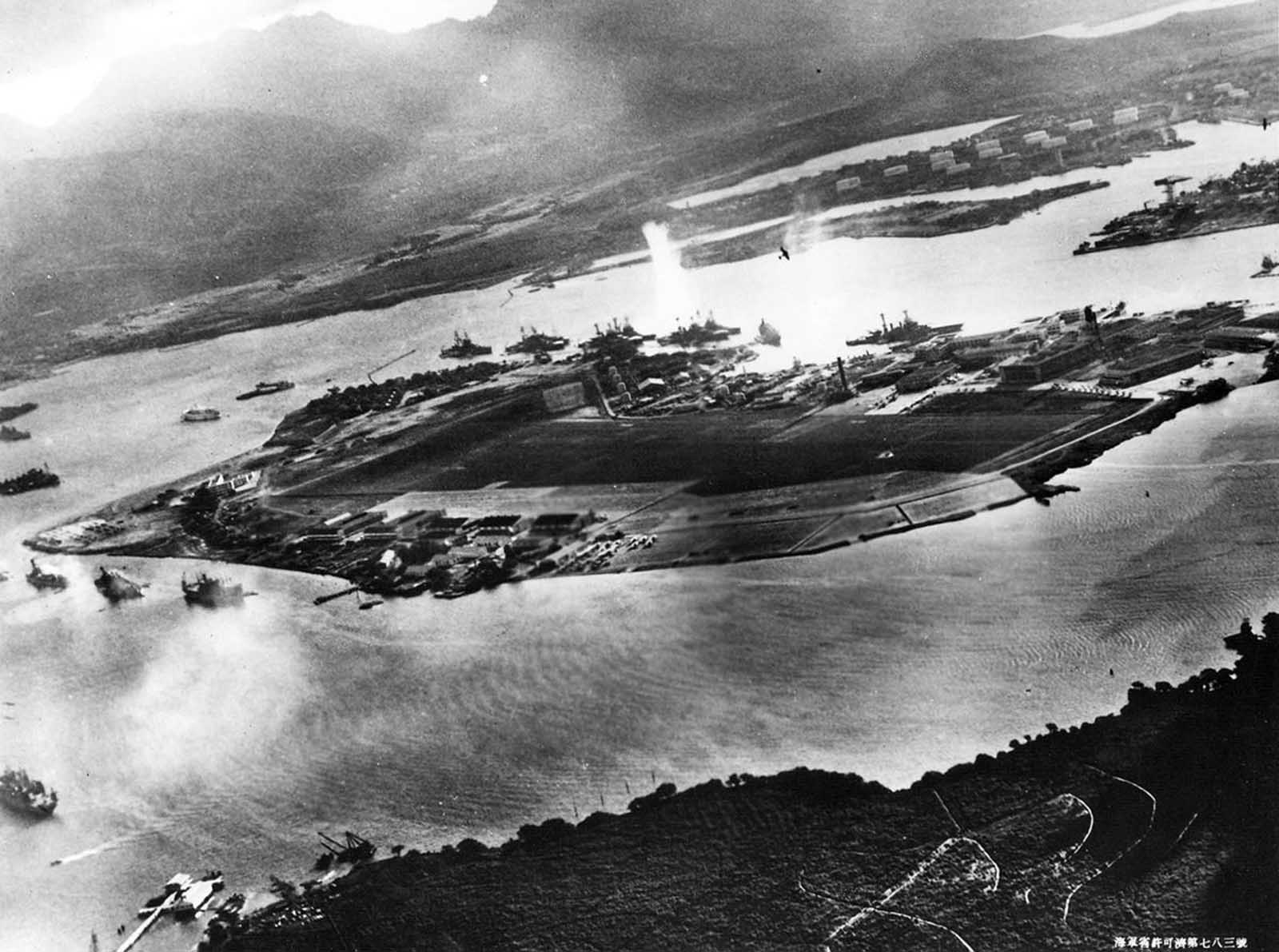
Japanese aircraft can be seen in the air above Pearl Harbor (top center and upper right) in this captured Japanese photograph taken during the initial moments of the Japanese attack.
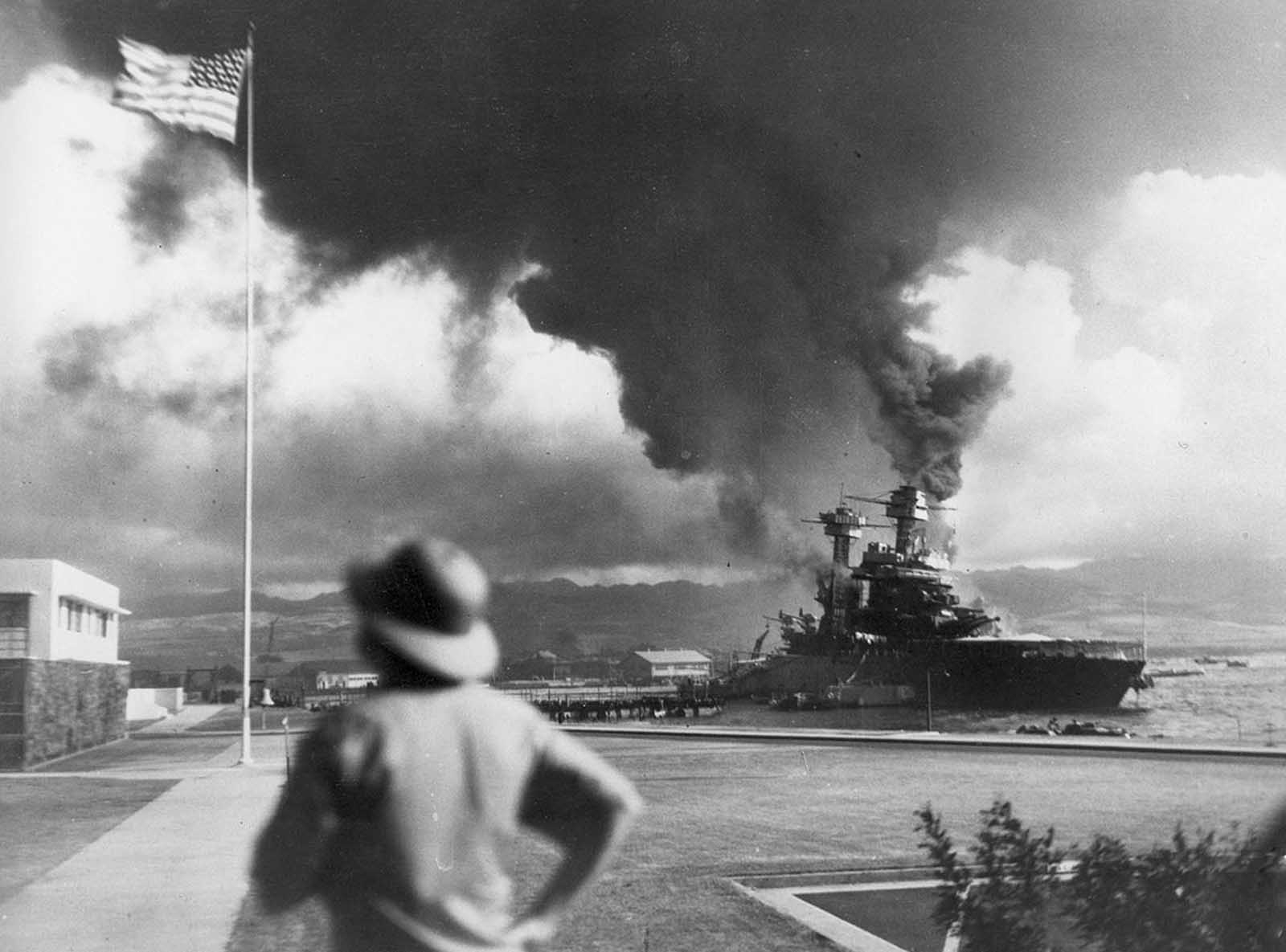
American ships burn during the Japanese attack on Pearl Harbor, Hawaii, on December 7, 1941.

A wide-angle view of the sky above Pearl Harbor, Hawaii, filled with smoke and anti-aircraft fire on December 7, 1941.

Officers’ wives, investigating explosions and seeing a smoke pall in distance on December 7, 1941, heard neighbor Mary Naiden, then an Army hostess who took this picture, exclaim “There are red circles on those planes overhead. They are Japanese!” Realizing war had come, the two women, stunned, started toward quarters.

Aerial photograph, taken by a Japanese pilot, of the attack on Pearl Harbor, a Japanese bomber in lower-right foreground.
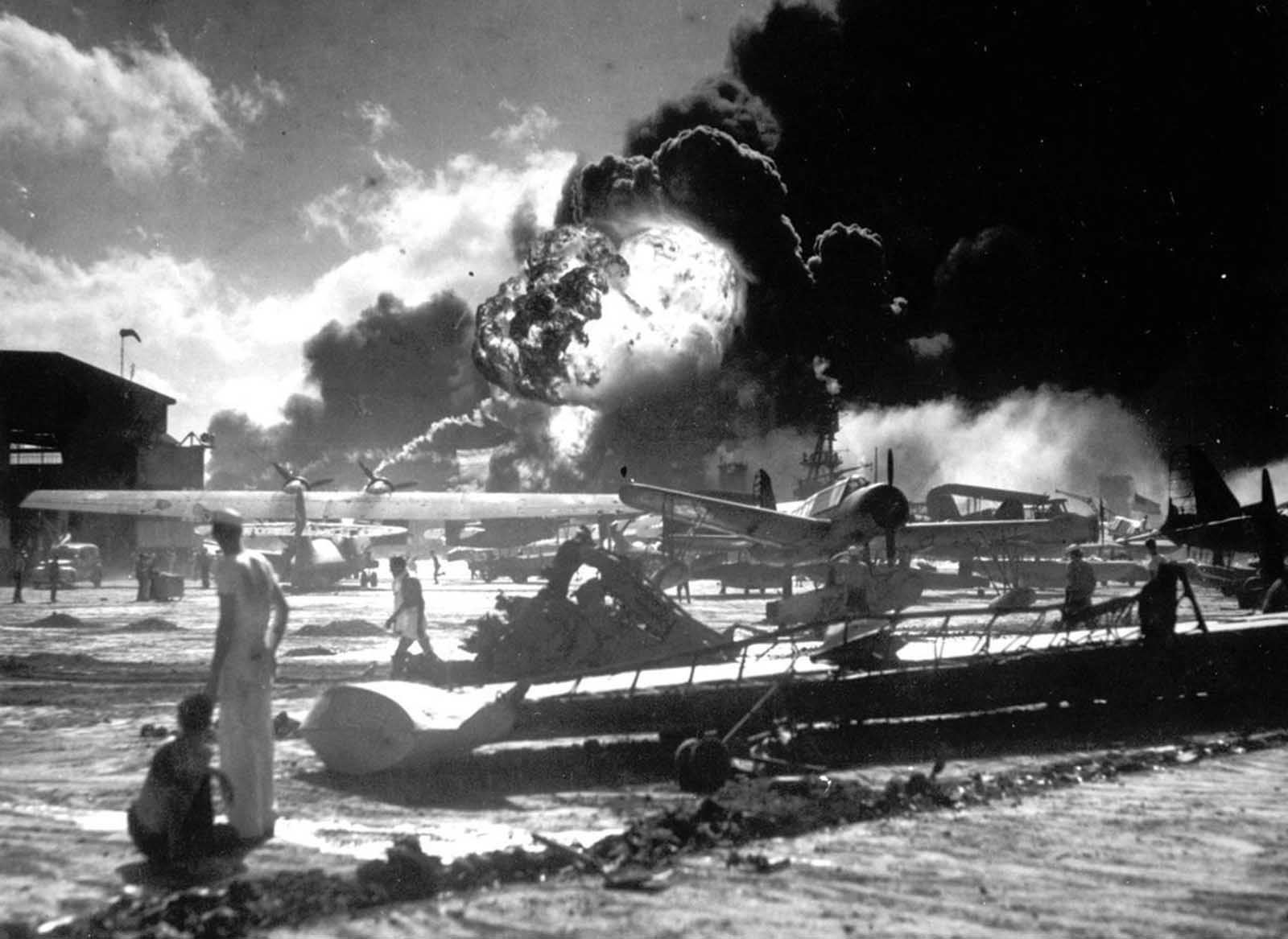
Sailors stand among wrecked airplanes at Ford Island Naval Air Station as they watch the explosion of the USS Shaw in the background, during the Japanese surprise attack on Pearl Harbor, Hawaii, December 7, 1941.

A U.S. flag flies from the stern of the sunken battleship USS West Virginia after the Japanese attack on Pearl Harbor, December 7, 1941.

An A6M-2 Zero fighter aboard the Imperial Japanese Navy carrier Akagi during the Pearl Harbor attack mission.

The USS Shaw burns in Pearl Harbor. Japanese bombers hit the forward portion of the ship with three bombs. The resulting fires proved uncontrollable, and Shaw was ordered abandoned. Soon after, her forward ammunition magazines detonated in a spectacular blast, completely removing her bow.

The USS California sinks into the mud of Pearl Harbor on December 7, 1941.

A small boat rescues a USS West Virginia crew member from the water after the Japanese bombing of Pearl Harbor, Hawaii, on December 7, 1941. Two men can be seen on the superstructure, upper center. The mast of the USS Tennessee is beyond the burning West Virginia.

The forward magazines of USS Arizona explode after she was hit by a Japanese bomb on December 7, 1941. Frame clipped from a color motion picture taken from on board USS Solace.

Japanese planes over Hawaii during the attack on Pearl Harbor are shown in this scene from a Japanese newsreel. The film was obtained by the U.S. War Department and later released to U.S. newsreels.

Sailors at Naval Air Station (NAS) Kaneohe attempt to salvage a burning PBY Catalina in the aftermath of the Japanese attack on Pearl Harbor.

The battleships West Virginia and Tennessee burning after the Japanese attack on Pearl Harbor, on December 7, 1941.

Oil burns on the waters of Pearl Harbor, near the naval air station, after the Japanese attack on Pearl Harbor on December 7, 1941.

The USS Maryland, a battleship moored inboard of the USS Oklahoma, which capsized, was damaged slightly in the Japanese attack on Pearl Harbor on December 7, 1941.
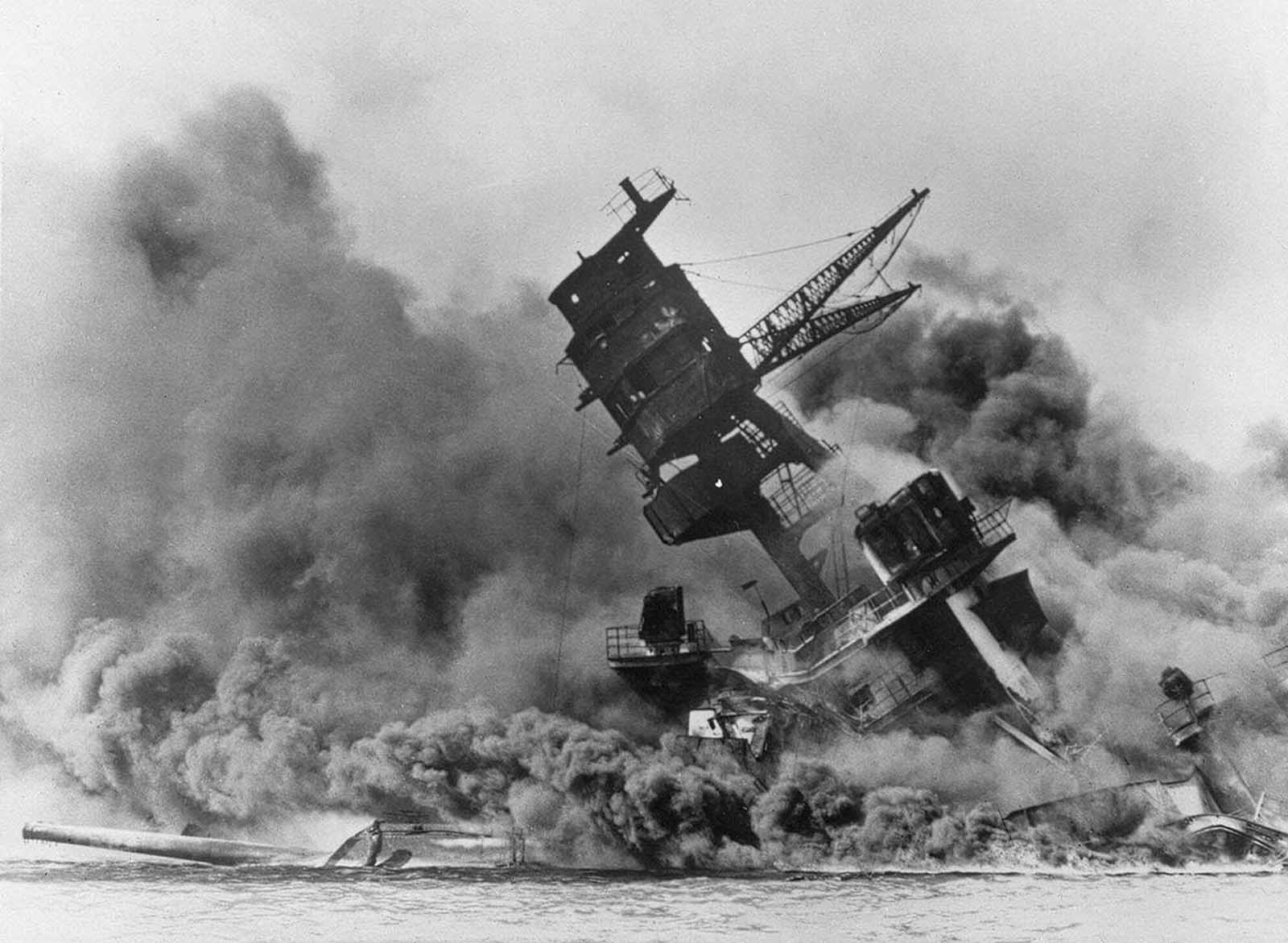
The battleship USS Arizona belches smoke as it topples over into the sea during a Japanese surprise attack on Pearl Harbor, Hawaii.

White House reporters dash for the telephones on December 7, 1941, after they had been told by presidential press secretary Stephen T. Early that Japanese submarines and planes had just bombed the U.S. Pacific fleet at Pearl Harbor, Hawaii.

Selling papers on December 7, 1941 at Times Square in New York City, announcing that Japan has attacked U.S. bases in the Pacific.
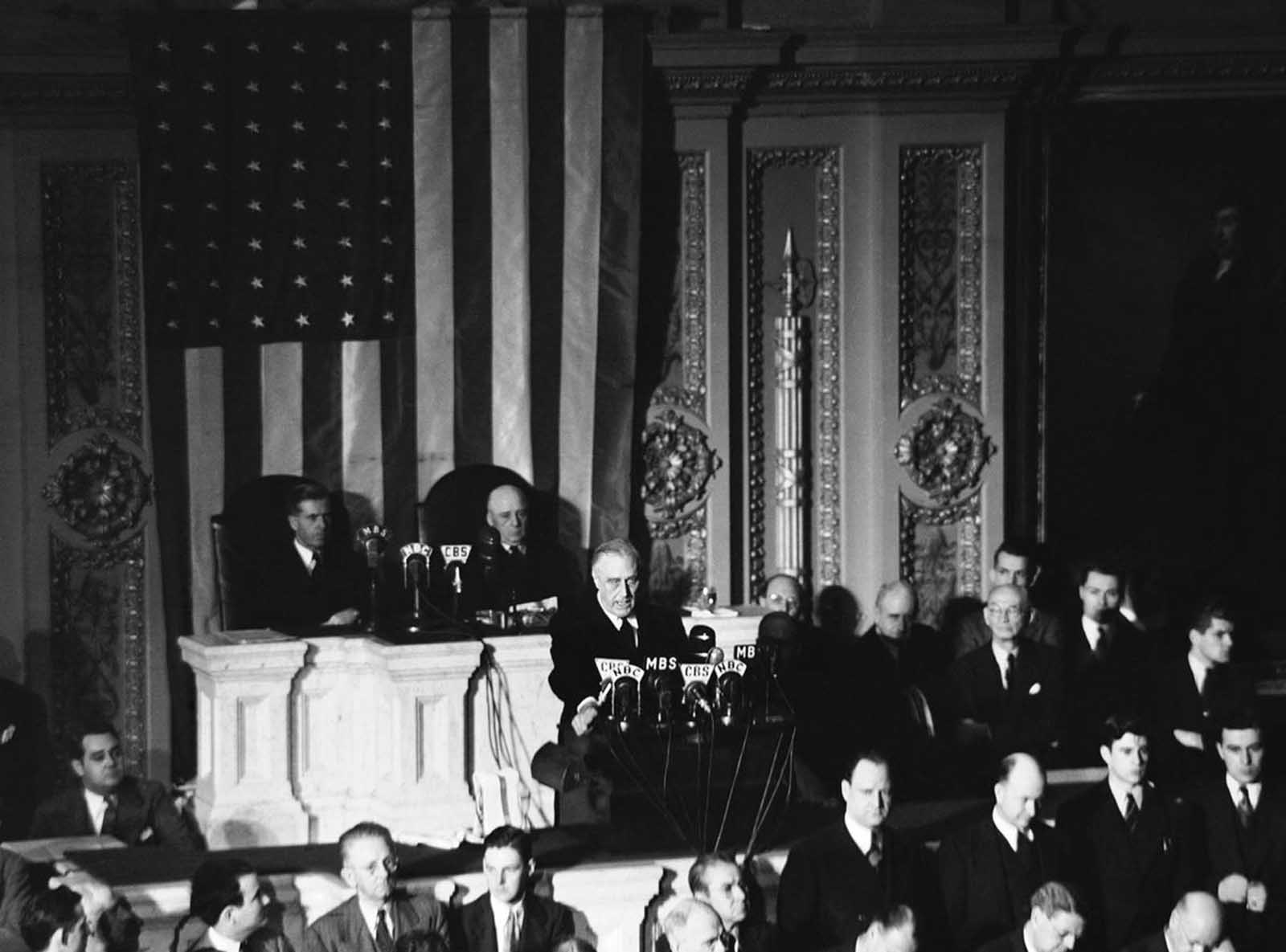
Declaring Japan guilty of a dastardly unprovoked attack, U.S. President Franklin D. Roosevelt asked Congress to declare war, on December 8, 1941. Listening are Vice President Henry Wallace, left, and House Speaker Sam Rayburn.
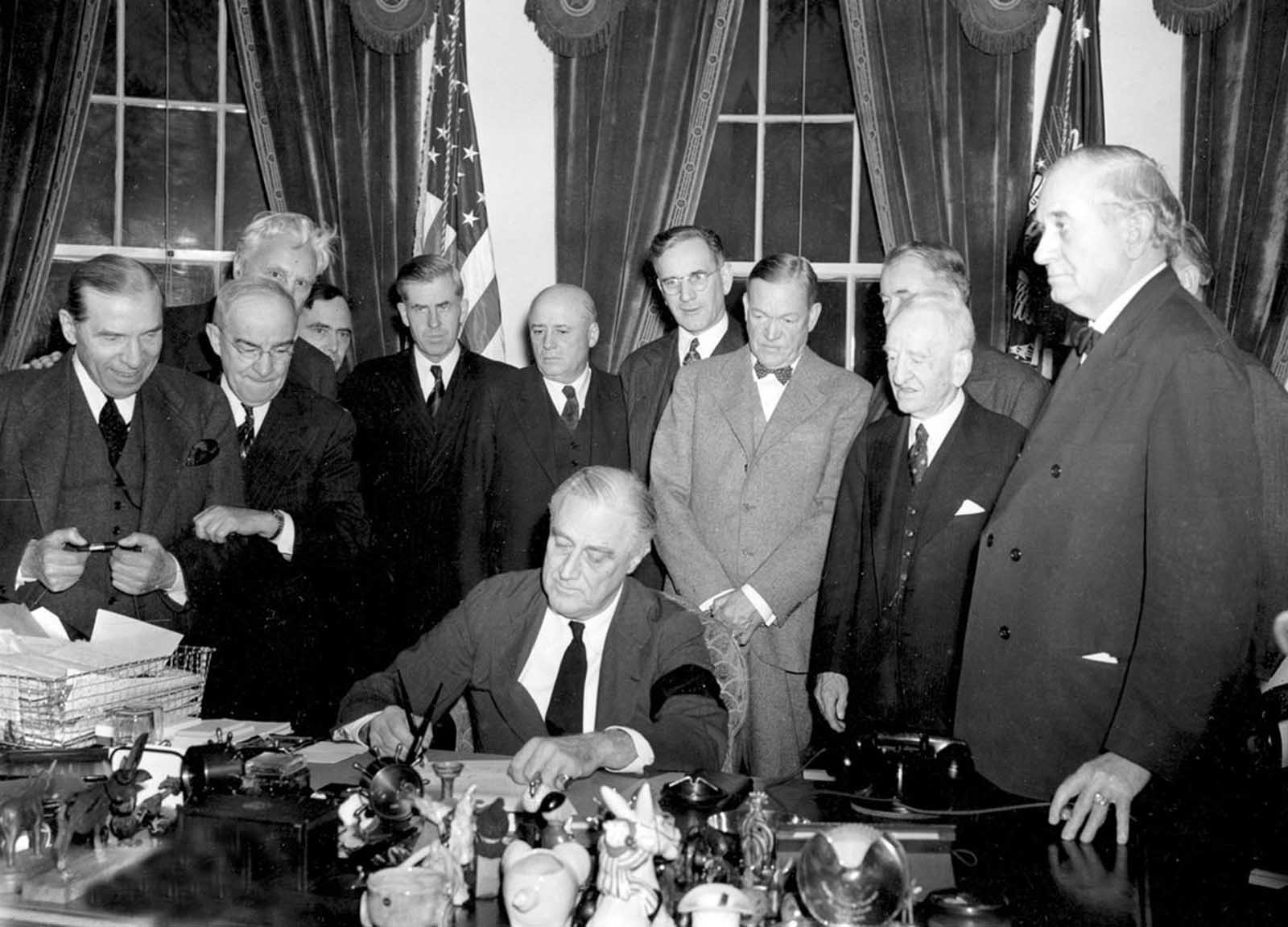
President Roosevelt signs the declaration of war following the Japanese bombing of Pearl Harbor, at the White House in Washington, District of Columbia, on December 8, 1941.

Young Japanese Americans, including several Army selectees, gather around a reporter’s car in the Japanese section of San Francisco, on December 8, 1941

The minelayer USS Oglala lies capsized after being attacked by Japanese aircraft and submarines in the attack on Pearl Harbor.
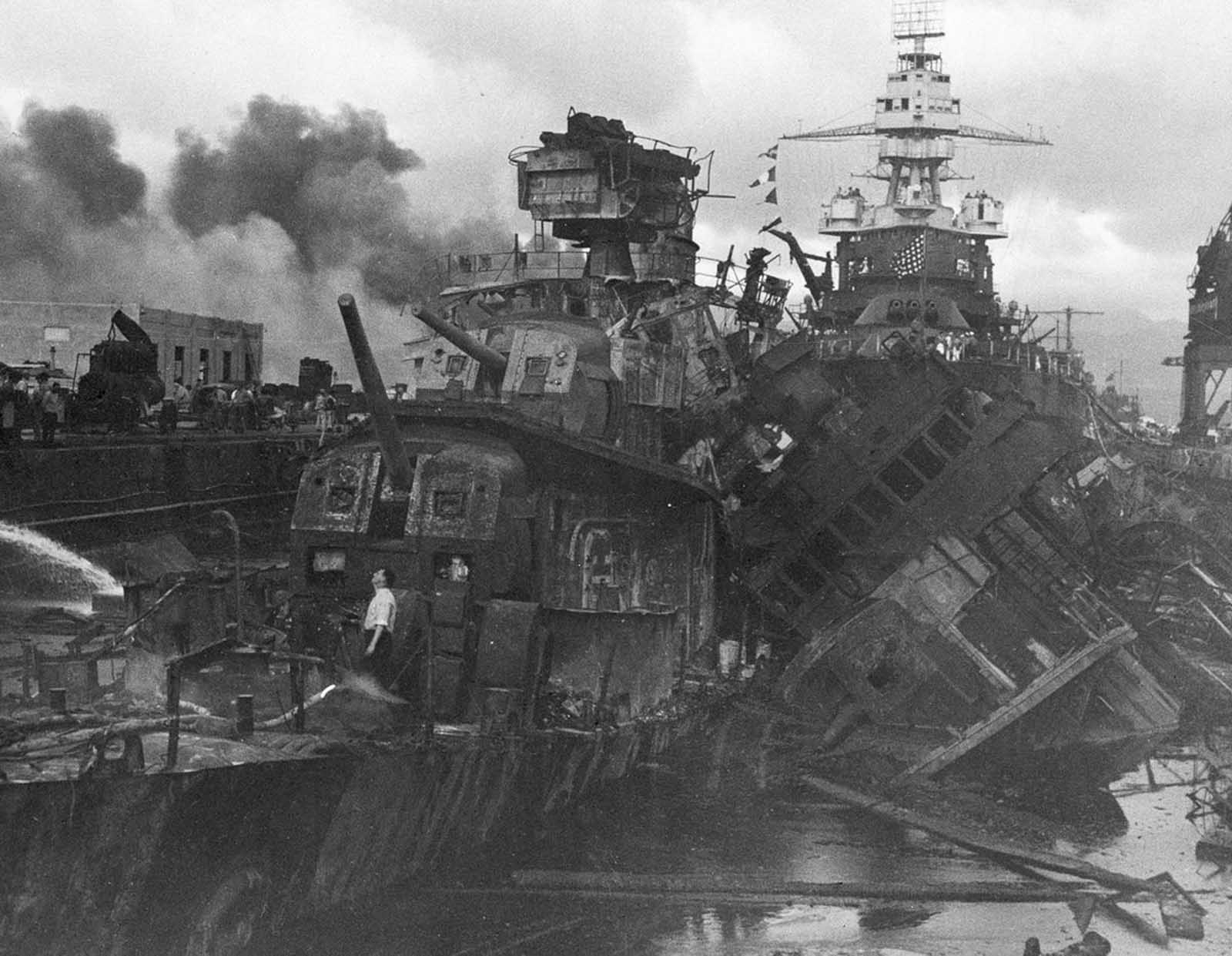
Heavy damage is seen on the destroyers USS Downes and USS Cassin, stationed at Pearl Harbor, after the Japanese attack on the Hawaiian island on December 7, 1941.

An interior shot of a destroyed aircraft hangar at Wheeler Field, in Hawaii, on December 11, 1941.

In this photo provided by the U.S. Navy, eight miles from Pearl Harbor, shrapnel from a Japanese bomb riddled this car and killed three civilians in the attack of December 7, 1941. Two of the victims can be seen in the front seat. The Navy reported there was no nearby military target.

Wreckage of the first Japanese plane shot down during the attack on Pearl Harbor on December 7, 1941.
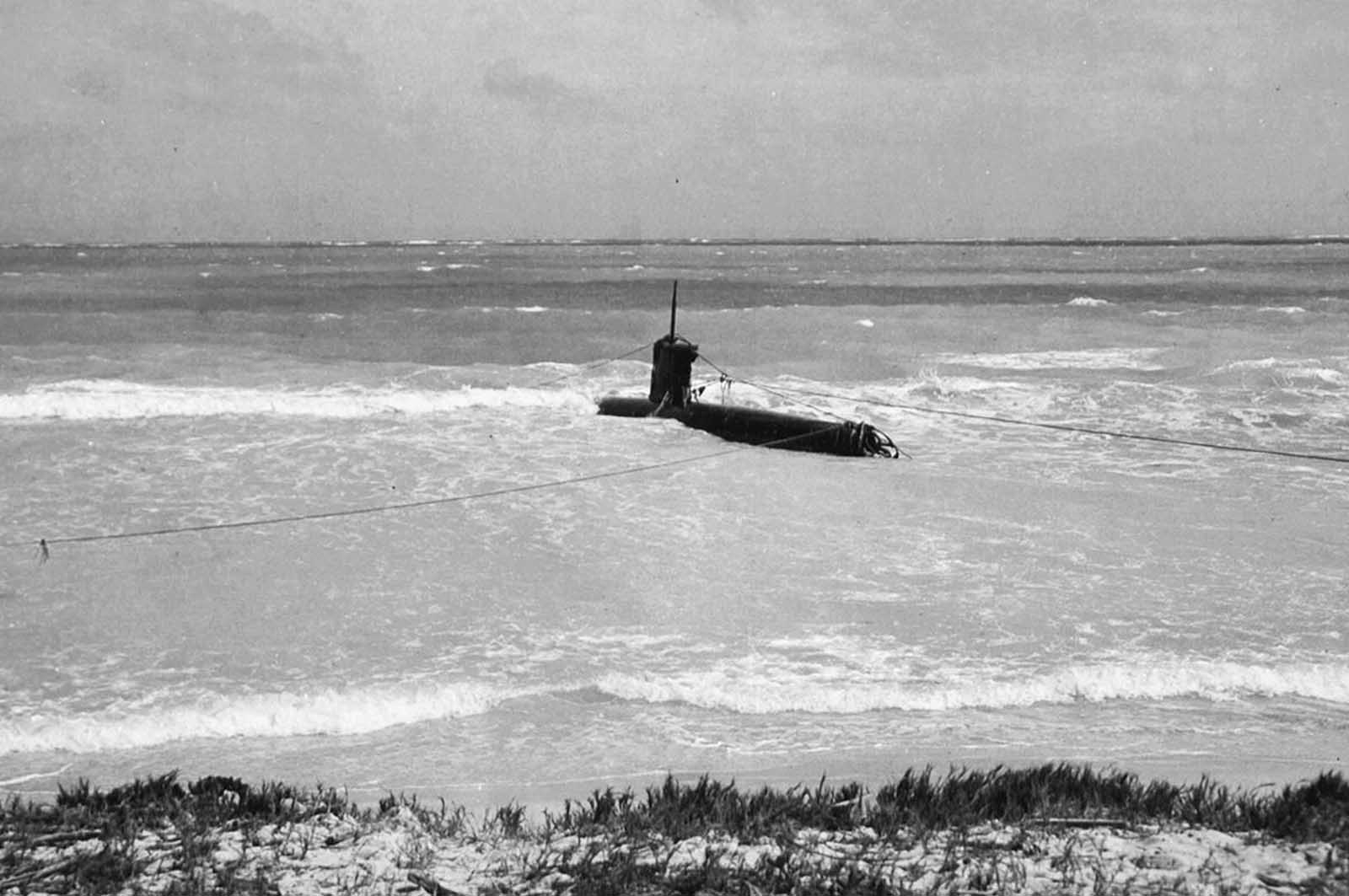
A Japanese midget submarine, part of the attacking force on Pearl Harbor, beached at Bellows Field.
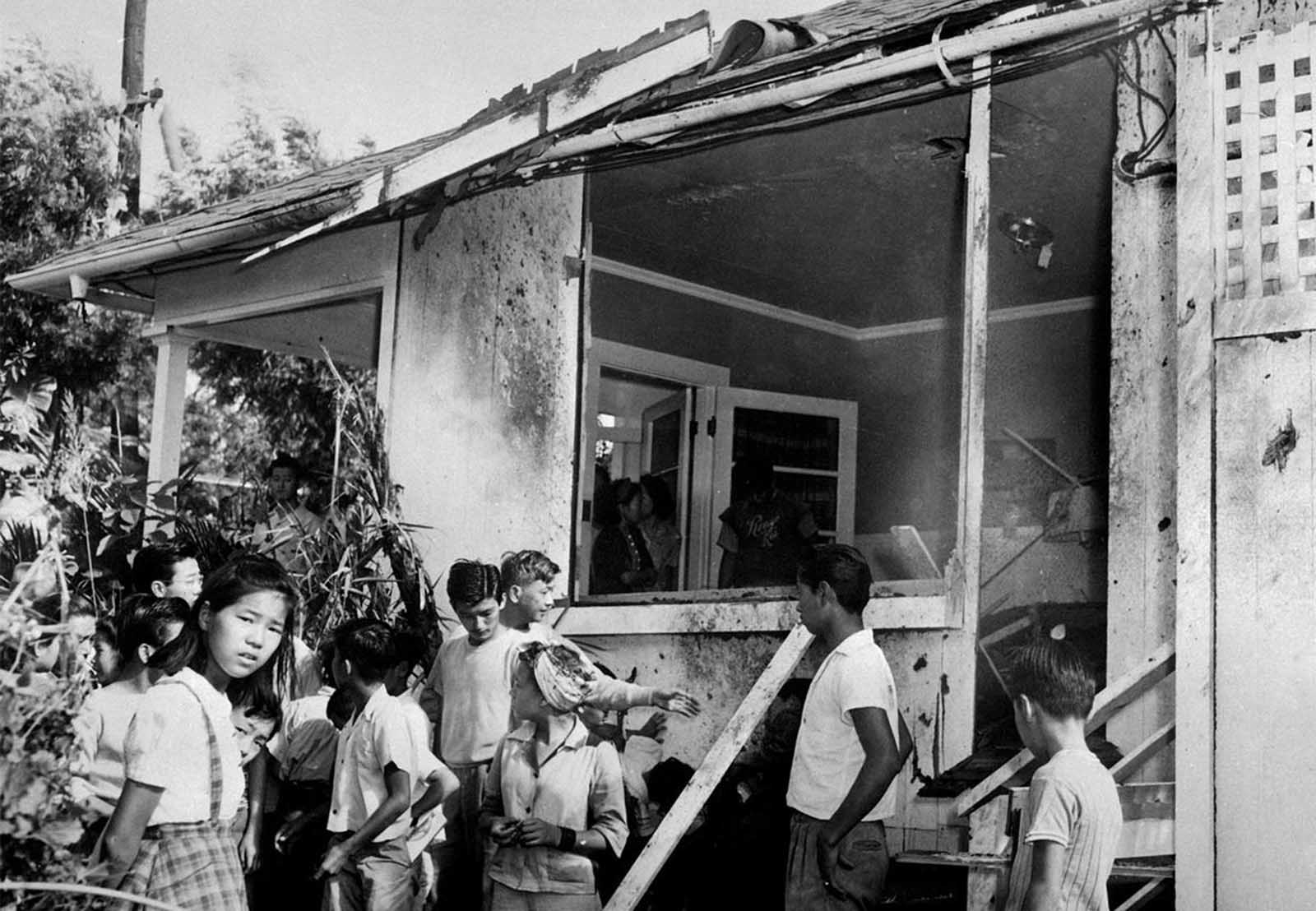
A small crowd inspects the damage, both inside and outside, after a Japanese bomb hit the residence of Paul Goo during the Japanese air raid on December 7, 1941.

Unidentified attaches of the Japanese consulate began burning papers, ledgers and other records shortly after Japan went to war against the U.S., on December 7, 1941, in New Orleans, Louisiana. Police later stopped the fire after most of the papers had been destroyed.

This unidentified Japanese man turns to face a visitor at the Japanese Consulate in Chicago, on December 9, 1941. Clad only in underwear, he was startled while in the act of taking papers and files from a cabinet. Confidential papers at the consulate had been burned.

Following Hawaiian tradition, sailors honor men killed during the December 7, 1941, Japanese attack on Naval Air Station Kaneohe, Oahu. The casualties had been buried on December 8. This ceremony took place sometime during the following months.
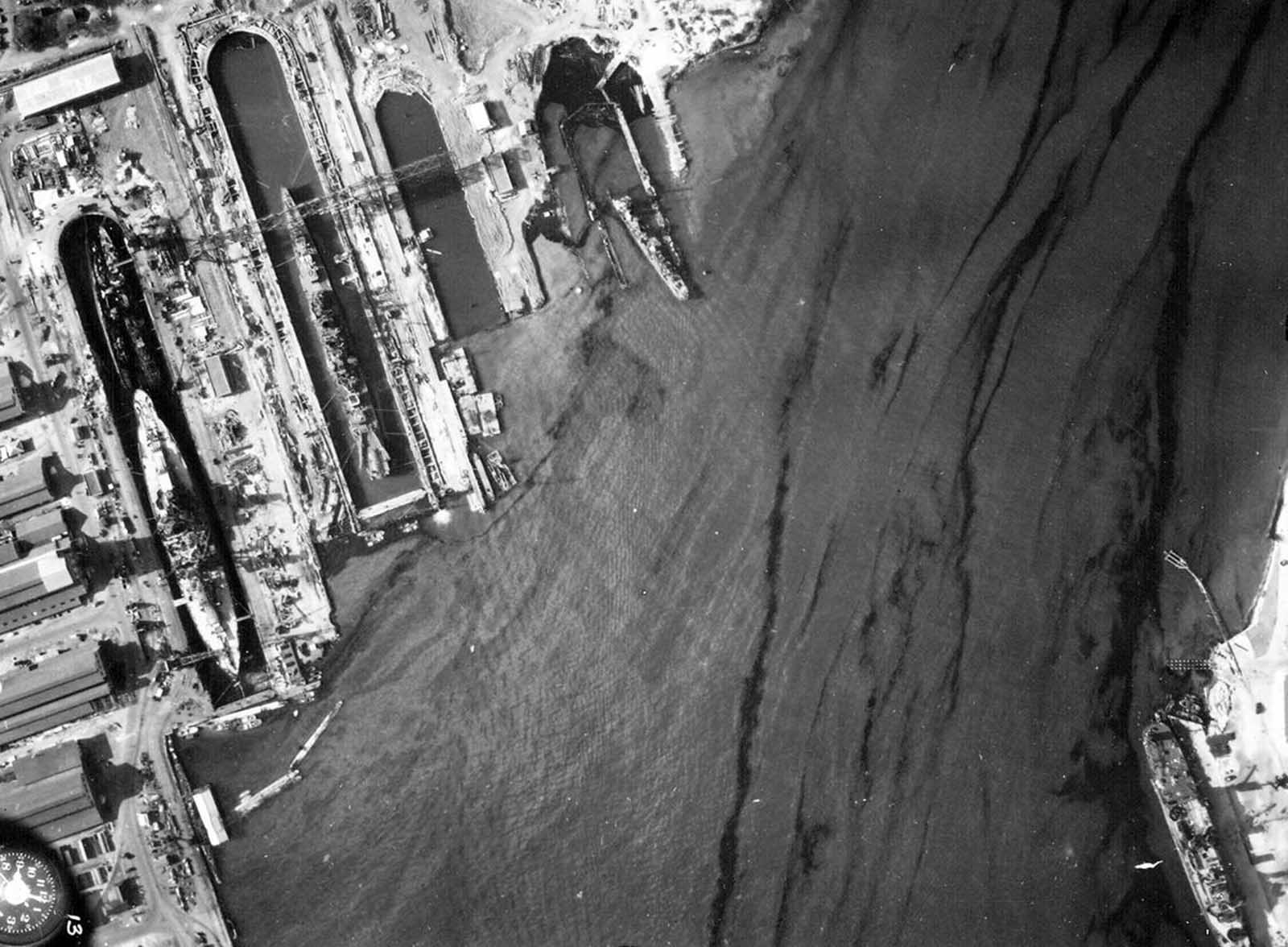
Aerial view showing oil-streaked waters and the dry docks at U.S. Naval Base Pearl Harbor, Hawaii, following the Japanese attack, seen on December 10, 1941.

The USS Shaw explodes after being hit by bombs during the Japanese surprise attack on Pearl Harbor, Hawaii, in this December 7, 1941 photo.
The Japanese surprise attack on Pearl Harbor began just before 8 a.m. local time Sunday morning, December 7, 1941. For over an hour, in two waves, some 350 Japanese aircraft—having taken off from six aircraft carriers 230 miles north of Oahu—attacked the naval base.
Japanese forces wreaked havoc on US naval vessels and on US aircraft on the island’s airfield. In all, 2,403 Americans, including 68 civilians, died in the attack. In comparison, Japan suffered relatively light causalities—it lost only 29 aircraft and a few mini-submarines.
The American people were shocked, bewildered, surprised, and angered by the attack. On December 8, President Roosevelt addressed a joint session of Congress in the Capitol, his words broadcast on radio to the nation: “Yesterday, December 7, 1941—a date which will live in infamy—the United States of America was suddenly and deliberately attacked by naval and air forces of the Empire of Japan”.

Japanese pilots get instructions aboard an aircraft carrier before the attack on Pearl Harbor, in this scene from a Japanese newsreel. It was obtained by the U.S. War Department and released to U.S. newsreels.
In his address, Roosevelt asked Congress to declare war against Japan, which it did that day. Three days later, Japan’s allies Germany and Italy declared war on the United States, and Congress reciprocated the same day.
All previous domestic opposition to US entry into the war ceased. The United States was now immersed in a war it would conduct simultaneously in Europe and the Pacific.
The Japanese government decided to attack Pearl Harbor after the United States cut off US oil exports to Japan in the summer of 1941. Japan relied on the United States for eighty percent of its oil, and without US oil supplies its navy would be unable to function.
In attacking Pearl Harbor the Japanese hoped to cripple or destroy the US Pacific fleet so that the Japanese navy would have free reign in the Pacific.

The Japanese aircraft carrier Zuikaku, seen in September of 1941. The Zuikaku would soon sail toward Hawaii, one of six aircraft carriers used in the attack by the Imperial Japanese Navy.
Japan was also motivated strategically by ideas of creating an Asian co-prosperity sphere—“Asia for Asians”—in which Japan would take over the Asian colonial holdings of Europe and the United States. With the British, French, and Dutch caught up in the war in Europe, the Japanese believed the European powers would be unable to defend their Asian colonial holdings.
Indeed, in the eight hours following the Pearl Harbor attack, Japan also attacked British-held Singapore, Hong Kong, and Malaya, and the US territorial possessions of the Philippines, Guam, and Wake Island.
While the attack accomplished its intended objective, it turned out to be largely unnecessary. Unbeknownst to Yamamoto, who conceived the original plan, the U.S. Navy had decided as far back as 1935 to abandon ‘charging’ across the Pacific towards the Philippines in response to an outbreak of war.
The U.S. instead adopted “Plan Dog” in 1940, which emphasized keeping the IJN out of the eastern Pacific and away from the shipping lanes to Australia, while the U.S. concentrated on defeating Nazi Germany.

Aircraft prepare to launch from the Imperial Japanese Navy aircraft carrier Akagi during the December 7, 1941 attack on Pearl Harbor, Hawaii.
Fortunately for the United States, the American aircraft carriers were untouched by the Japanese attack; otherwise the Pacific Fleet’s ability to conduct offensive operations would have been crippled for a year or more (given no diversions from the Atlantic Fleet).
As it was, the elimination of the battleships left the U.S. Navy with no choice but to rely on its aircraft carriers and submarines—the very weapons with which the U.S. Navy halted and eventually reversed the Japanese advance.
While six of the eight battleships were repaired and returned to service, their relatively low speed and high fuel consumption limited their deployment, and they served mainly in shore bombardment roles (their only major action being the Battle of Surigao Strait in October 1944).
A major flaw of Japanese strategic thinking was a belief that the ultimate Pacific battle would be fought by battleships, in keeping with the doctrine of Captain Alfred Thayer Mahan. As a result, Yamamoto (and his successors) hoarded battleships for a “decisive battle” that never happened.

This photograph, from a Japanese film later captured by American forces, was taken aboard the Japanese aircraft carrier Zuikaku, just as a Nakajima “Kate” B-5N bomber launched off the deck to attack Pearl Harbor, Hawaii, on December 7, 1941.

Aerial view of the initial blows struck against American ships, as seen from a Japanese plane over Pearl Harbor.

Captured Japanese photograph taken during the attack on Pearl Harbor, December 7, 1941. In the distance, the smoke rises from Hickam Field.

Seen from a distance, the Battleship Arizona burns as it sinks in Pearl Harbor after the December 7, 1941 raid by Japanese bombers.

A Japanese bomber, its diving flaps down, was photographed by a U.S. Navy photographer as the plane approached its Pearl Harbor objective on December 7.

Japanese aircraft can be seen in the air above Pearl Harbor (top center and upper right) in this captured Japanese photograph taken during the initial moments of the Japanese attack.

American ships burn during the Japanese attack on Pearl Harbor, Hawaii, on December 7, 1941.

A wide-angle view of the sky above Pearl Harbor, Hawaii, filled with smoke and anti-aircraft fire on December 7, 1941.

Officers’ wives, investigating explosions and seeing a smoke pall in distance on December 7, 1941, heard neighbor Mary Naiden, then an Army hostess who took this picture, exclaim “There are red circles on those planes overhead. They are Japanese!” Realizing war had come, the two women, stunned, started toward quarters.

Aerial photograph, taken by a Japanese pilot, of the attack on Pearl Harbor, a Japanese bomber in lower-right foreground.

Sailors stand among wrecked airplanes at Ford Island Naval Air Station as they watch the explosion of the USS Shaw in the background, during the Japanese surprise attack on Pearl Harbor, Hawaii, December 7, 1941.

A U.S. flag flies from the stern of the sunken battleship USS West Virginia after the Japanese attack on Pearl Harbor, December 7, 1941.

An A6M-2 Zero fighter aboard the Imperial Japanese Navy carrier Akagi during the Pearl Harbor attack mission.

The USS Shaw burns in Pearl Harbor. Japanese bombers hit the forward portion of the ship with three bombs. The resulting fires proved uncontrollable, and Shaw was ordered abandoned. Soon after, her forward ammunition magazines detonated in a spectacular blast, completely removing her bow.

The USS California sinks into the mud of Pearl Harbor on December 7, 1941.

A small boat rescues a USS West Virginia crew member from the water after the Japanese bombing of Pearl Harbor, Hawaii, on December 7, 1941. Two men can be seen on the superstructure, upper center. The mast of the USS Tennessee is beyond the burning West Virginia.

The forward magazines of USS Arizona explode after she was hit by a Japanese bomb on December 7, 1941. Frame clipped from a color motion picture taken from on board USS Solace.

Japanese planes over Hawaii during the attack on Pearl Harbor are shown in this scene from a Japanese newsreel. The film was obtained by the U.S. War Department and later released to U.S. newsreels.

Sailors at Naval Air Station (NAS) Kaneohe attempt to salvage a burning PBY Catalina in the aftermath of the Japanese attack on Pearl Harbor.

The battleships West Virginia and Tennessee burning after the Japanese attack on Pearl Harbor, on December 7, 1941.

Oil burns on the waters of Pearl Harbor, near the naval air station, after the Japanese attack on Pearl Harbor on December 7, 1941.

The USS Maryland, a battleship moored inboard of the USS Oklahoma, which capsized, was damaged slightly in the Japanese attack on Pearl Harbor on December 7, 1941.

The battleship USS Arizona belches smoke as it topples over into the sea during a Japanese surprise attack on Pearl Harbor, Hawaii.

White House reporters dash for the telephones on December 7, 1941, after they had been told by presidential press secretary Stephen T. Early that Japanese submarines and planes had just bombed the U.S. Pacific fleet at Pearl Harbor, Hawaii.

Selling papers on December 7, 1941 at Times Square in New York City, announcing that Japan has attacked U.S. bases in the Pacific.

Declaring Japan guilty of a dastardly unprovoked attack, U.S. President Franklin D. Roosevelt asked Congress to declare war, on December 8, 1941. Listening are Vice President Henry Wallace, left, and House Speaker Sam Rayburn.

President Roosevelt signs the declaration of war following the Japanese bombing of Pearl Harbor, at the White House in Washington, District of Columbia, on December 8, 1941.

Young Japanese Americans, including several Army selectees, gather around a reporter’s car in the Japanese section of San Francisco, on December 8, 1941

The minelayer USS Oglala lies capsized after being attacked by Japanese aircraft and submarines in the attack on Pearl Harbor.

Heavy damage is seen on the destroyers USS Downes and USS Cassin, stationed at Pearl Harbor, after the Japanese attack on the Hawaiian island on December 7, 1941.

An interior shot of a destroyed aircraft hangar at Wheeler Field, in Hawaii, on December 11, 1941.

In this photo provided by the U.S. Navy, eight miles from Pearl Harbor, shrapnel from a Japanese bomb riddled this car and killed three civilians in the attack of December 7, 1941. Two of the victims can be seen in the front seat. The Navy reported there was no nearby military target.

Wreckage of the first Japanese plane shot down during the attack on Pearl Harbor on December 7, 1941.

A Japanese midget submarine, part of the attacking force on Pearl Harbor, beached at Bellows Field.

A small crowd inspects the damage, both inside and outside, after a Japanese bomb hit the residence of Paul Goo during the Japanese air raid on December 7, 1941.

Unidentified attaches of the Japanese consulate began burning papers, ledgers and other records shortly after Japan went to war against the U.S., on December 7, 1941, in New Orleans, Louisiana. Police later stopped the fire after most of the papers had been destroyed.

This unidentified Japanese man turns to face a visitor at the Japanese Consulate in Chicago, on December 9, 1941. Clad only in underwear, he was startled while in the act of taking papers and files from a cabinet. Confidential papers at the consulate had been burned.

Following Hawaiian tradition, sailors honor men killed during the December 7, 1941, Japanese attack on Naval Air Station Kaneohe, Oahu. The casualties had been buried on December 8. This ceremony took place sometime during the following months.

Aerial view showing oil-streaked waters and the dry docks at U.S. Naval Base Pearl Harbor, Hawaii, following the Japanese attack, seen on December 10, 1941.